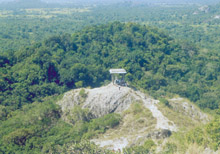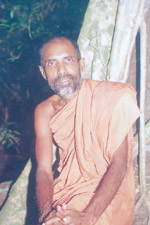The secret garden in Dambulla
Jathika Namal Uyana
by Ranga Jayasuriya - Daily News, Wed Mar 27,
2002
 March
28 marks the 11th anniversary of the Jathika Namal Uyana (National Naa Park) in
Dambulla, Galkiriyagama. In 1991, a solitary monk made his ashram in this
ancient site then encroached by the dense forest. Eleven years after it was
re-discovered by Vanavasi Rahula thera, now Namal Uyana is considered the
largest Naa tree forest in the country and the home to the largest Rose Quartz
Mountain Range in South Asia.
March
28 marks the 11th anniversary of the Jathika Namal Uyana (National Naa Park) in
Dambulla, Galkiriyagama. In 1991, a solitary monk made his ashram in this
ancient site then encroached by the dense forest. Eleven years after it was
re-discovered by Vanavasi Rahula thera, now Namal Uyana is considered the
largest Naa tree forest in the country and the home to the largest Rose Quartz
Mountain Range in South Asia.
Legend has it that King Devanampiyatissa planned
to set up a religious park somewhere near Dambulla, but the construction was
delayed due to some unexpected reasons and the king was compelled to move the
proposed site for his dream park to somewhere near Anuradhapura - in the heart
of the capital of his kingdom. Ultimately he set it up, it was called Mahamevna
Uyana. What happened to the abandoned site near Dambulla for the next few
centuries was a mystery.

Vanavasi Rahula Thera - The founder of the Namal
Uyana |
But the abandoned garden came into light in 924
AD, when the then King Dappula IV declared it as a human sanctuary. Thus the
first ever human sanctuary in local history was set up.
Men who sought refuge from the persecution of the
king and his officials had protection of the monks who controlled the monastery.
No official could take them into custody without the permission of the monks who
hardly consented to hand over their refugees. An inscription by the King Dappula
IV declaring the religious site as a human sanctuary can still be seen at
Adiyagala at the entrance to Namal Uyana.
It is said that the monks in the monastery asked
these refugees to plant and look after a few trees of Naa in the sanctuary
premises as an act of self retribution. Subsequently this simple act led to the
largest Iron wood (Naa) park in South Asia.
With the time passed and the Sinhala kingdom
moving further into the countryside for protection from the South Indian
invaders, the monastery and the Naa park was abandoned. No detail of the
monastery is available since it was abandoned.
But in March 1991, a solitary monk came to this
isolated once religious habitat. He too was an enigma. Very little is known
about his life before he came to this ancient religious site away from the human
habitation. He had his hut 40 feet above in a tree top to avoid danger from
freely roaming wild animals.
Now with 11 years passed since then, this once
solitary monk now widely known as Vanavasi Rahula Thero recalls his difficult
days with nostalgia. He is proud to call himself a the pioneer and the protector
of this site of bio diversity.
According to him some Naa trees in the park are
older then 1500 years. Two varieties of Naa - Diya Naa and Batu Naa can be seen
there and the former is considered to be endemic to Sri Lanka.
According to the biologists the importance of the
Namal Uyana is that it has 102 species of tropical plants of which 82 are herbal
plants within 260 acres garden and the forest bordering it. The greater part of
plants are considered endemic to Sri Lanka and at the danger of extinction. 18
bird species and a number of mammals including elephant, leopard, monkey and
deer also dwell in the park and its proximity. Archaeological findings of stone
tombs, 'Sandakada Pahana', and inscriptions reveal that the history of this site
goes back to 300 AD.
Biodiversity is not the only distinction of the
place. The Rose Quartz mountain range which encompasses 500 acres has added
geological importance to this isolated garden 160 km from Colombo.
According to Prof. Shiran Daraniyagala, the Rose
Quartz Mountain Range is over 500 million years old and white, rose and violet
colour quartz deposits can be seen in the mountain range. It is said that pieces
of rose quartz of the mountain range had been used for the graving structures of
the Taj Mahal.
The geological importance of the Rose Quartz Park
was further highlighted last January, when the tree fossils considered to be
belonging to pre-historic era were discovered by Sri Lankan archaeologist Bandu
Weerawardene.
According to him fossils are about 10-15 million
years old. Though many animal fossils have been found in Sri Lanka this is the
first ever discovery of tree fossils in the country and according to
Weerawardhane no place with such a wide spread of fossils like in rose quartz
range in Namal Uyana was ever discovered. Fossils can be seen in 20-30 acres of
the mountain range.
Monk Vanavasi Rahula is happy with the fact that
his stay in the garden has reduced the intensity of deforestation and hunting in
the site. But it does not mean all challenges to the protection of the religious
site have been won.

Today Namal Uyana is a tourist attraction with
hundreds of locals and foreigners visiting throughout the year. |
The monk laments that the exposure of human
contact has endangered the fauna and flora of the site. According to him the
threat arises not from the organised groups, but from the villagers struck by
poverty. Hunting and deforestation are only a humble attempt for survival.
Vanavasi Rahula Thera advocates increasing
awareness of villagers on environment protection and improving their income
generation opportunities. Namal Uyana Environment Centre has taken steps to
educate local children on environment protection and train youth in environment
protection.
So when the Namal Uyana celebrates its 11th
anniversary sustainable socio-economic development with the co existence of the
environment should be the theme for the celebration.
 March
28 marks the 11th anniversary of the Jathika Namal Uyana (National Naa Park) in
Dambulla, Galkiriyagama. In 1991, a solitary monk made his ashram in this
ancient site then encroached by the dense forest. Eleven years after it was
re-discovered by Vanavasi Rahula thera, now Namal Uyana is considered the
largest Naa tree forest in the country and the home to the largest Rose Quartz
Mountain Range in South Asia.
March
28 marks the 11th anniversary of the Jathika Namal Uyana (National Naa Park) in
Dambulla, Galkiriyagama. In 1991, a solitary monk made his ashram in this
ancient site then encroached by the dense forest. Eleven years after it was
re-discovered by Vanavasi Rahula thera, now Namal Uyana is considered the
largest Naa tree forest in the country and the home to the largest Rose Quartz
Mountain Range in South Asia.

